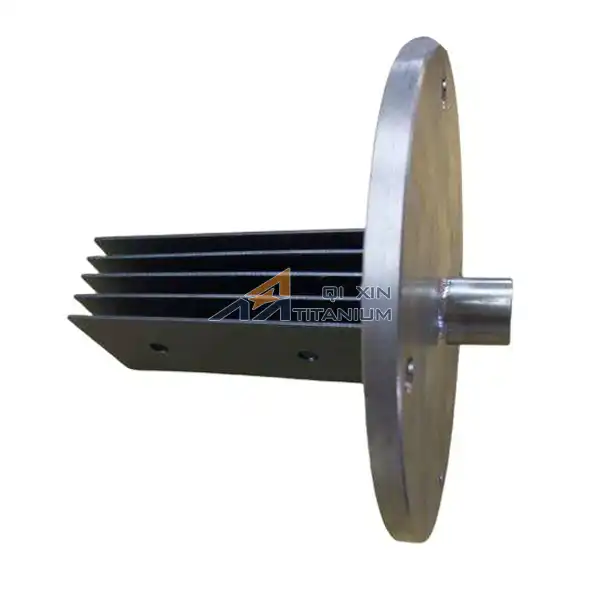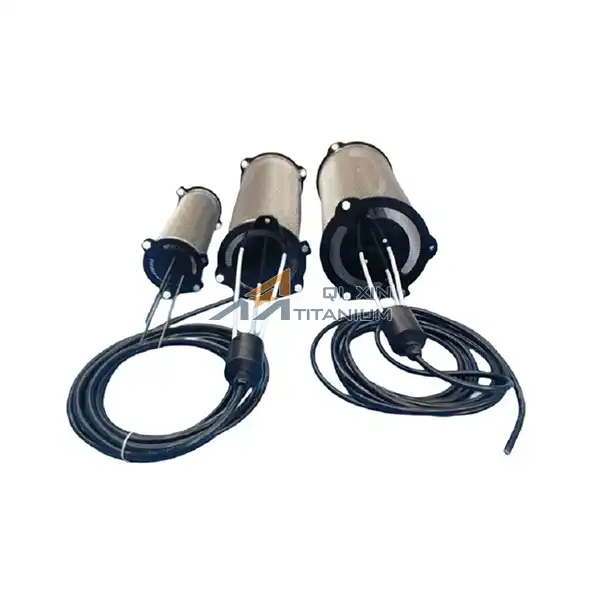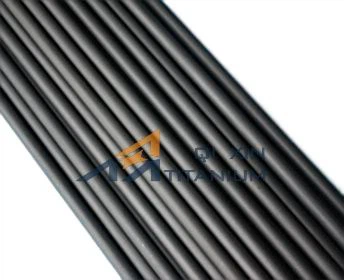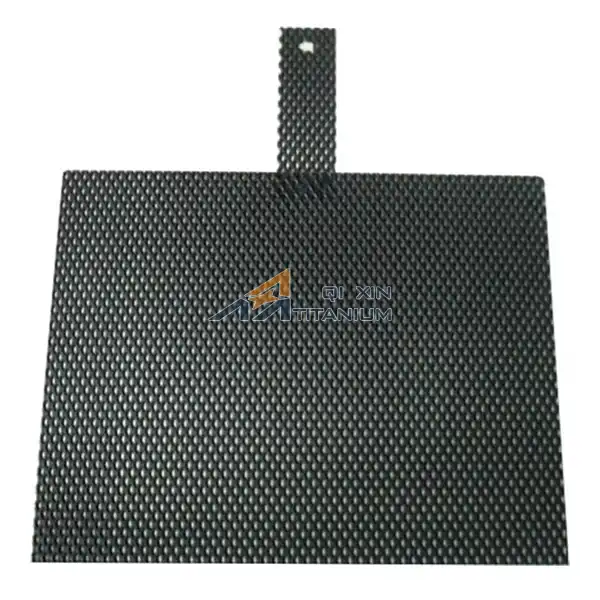Key Maintenance Tips for Platinum Plated Titanium Mesh Electrodes in Sodium Hypochlorite Generators
2025-04-15 09:31:45
Maintaining platinum plated titanium mesh electrodes in sodium hypochlorite generators is crucial for ensuring optimal performance and longevity. These electrodes play a vital role in the electrolysis process, producing sodium hypochlorite for various industrial and commercial applications. Proper maintenance involves regular cleaning, inspection, and careful handling to prevent damage and extend the electrode's lifespan. By following best practices such as monitoring operating conditions, performing scheduled maintenance, and addressing issues promptly, operators can maximize the efficiency and durability of their platinum plated titanium mesh electrodes, ultimately improving the overall performance of their sodium hypochlorite generation systems.
Understanding Platinum Plated Titanium Mesh Electrodes
Composition and Structure
Platinum plated titanium mesh electrodes are sophisticated components designed for use in electrochemical processes. The base material, titanium, is chosen for its excellent corrosion resistance and mechanical strength. The mesh structure provides a large surface area, enhancing the electrode's efficiency in electrolytic reactions. The platinum coating, applied through advanced plating techniques, serves as the catalytic surface where the electrochemical reactions occur.
Role in Sodium Hypochlorite Generation
In sodium hypochlorite generators, these electrodes facilitate the electrolysis of saltwater (brine) to produce sodium hypochlorite. The platinum coating catalyzes the oxidation of chloride ions to chlorine gas, which then reacts with sodium hydroxide to form sodium hypochlorite. This process is fundamental in creating a powerful disinfectant used in water treatment, sanitization, and various industrial applications.
Importance of Proper Maintenance
Maintaining platinum plated titanium mesh electrode is paramount for several reasons. First, it ensures consistent and efficient sodium hypochlorite production. Well-maintained electrodes operate at peak performance, reducing energy consumption and maximizing output. Second, proper care extends the electrode's lifespan, delaying the need for costly replacements. Lastly, it helps prevent the degradation of the platinum coating, which could lead to contamination of the produced sodium hypochlorite and reduced effectiveness.
Essential Maintenance Procedures
Regular Cleaning Protocols
Implementing a robust cleaning regimen is crucial for maintaining the efficiency of platinum plated titanium mesh electrodes. Over time, these electrodes can accumulate mineral deposits, organic matter, and other contaminants that impede their performance. A systematic cleaning approach involves several steps:
- Frequency: Establish a cleaning schedule based on operational hours and water quality. Typically, cleaning every 500-1000 hours of operation is recommended, but this may vary depending on specific conditions.
- Chemical Cleaning: Use a dilute acid solution, such as hydrochloric acid (HCl) or citric acid, to dissolve mineral deposits. The concentration and exposure time should be carefully controlled to avoid damaging the platinum coating.
- Mechanical Cleaning: Gently brush the electrode surface with a soft-bristled brush to remove loose debris. Avoid using abrasive materials that could scratch or damage the platinum layer.
- Rinsing: Thoroughly rinse the electrodes with deionized water after cleaning to remove all traces of cleaning agents and dislodged contaminants.
Inspection and Monitoring Techniques
Regular inspection and monitoring are essential for identifying potential issues before they escalate. Implement the following techniques:
- Visual Inspection: Regularly examine the electrode surface for signs of wear, discoloration, or damage to the platinum coating.
- Performance Monitoring: Track key performance indicators such as current efficiency, voltage requirements, and chlorine production rates. Any significant deviations may indicate electrode degradation.
- Electrochemical Testing: Periodically conduct polarization tests to assess the electrode's catalytic activity and identify any loss in performance.
- Surface Analysis: Utilize advanced techniques like scanning electron microscopy (SEM) or X-ray photoelectron spectroscopy (XPS) for in-depth analysis of the electrode surface, if feasible.
Preventive Maintenance Strategies
Implementing preventive maintenance strategies can significantly extend the life of platinum plated titanium mesh electrodes:
- Water Quality Management: Maintain optimal water quality by controlling pH, hardness, and conductivity. Use water softeners or reverse osmosis systems if necessary to reduce mineral content in the feed water.
- Operating Parameter Control: Adhere to recommended current densities and voltage ranges to prevent accelerated wear of the platinum coating.
- Polarity Reversal: Implement periodic polarity reversal if your system allows, as this can help distribute wear evenly across the electrode surface and prevent localized degradation.
- Scheduled Downtime: Plan for regular maintenance periods to allow for thorough cleaning and inspection without disrupting production schedules.
Troubleshooting Common Issues
Identifying Performance Decline
Recognizing signs of electrode performance decline is crucial for timely intervention. Key indicators include:
- Reduced Chlorine Output: A decrease in sodium hypochlorite production despite consistent input parameters may indicate electrode degradation.
- Increased Power Consumption: If more electrical energy is required to maintain the same level of production, it could signify electrode wear or coating loss.
- Voltage Fluctuations: Unstable or increasing cell voltage during operation often points to electrode issues.
- Visual Changes: Discoloration, pitting, or visible wear on the electrode surface are clear signs of potential problems.
Addressing Coating Deterioration
The platinum coating on platinum plated titanium mesh electrodes can deteriorate over time, impacting performance and efficiency. To address this:
- Recoating: When significant coating loss is observed, consider recoating the electrodes. This process should be performed by experienced professionals to ensure proper adhesion and uniform coating thickness.
- Partial Replacement: In cases where only certain sections show wear, partial replacement of the affected areas may be possible, depending on the electrode design.
- Coating Analysis: Conduct periodic analysis of the platinum coating thickness using techniques like X-ray fluorescence (XRF) to track wear rates and plan for timely recoating or replacement.
Optimizing Operating Conditions
Fine-tuning operating conditions can help mitigate issues and extend electrode life:
- Current Density Adjustment: Optimize current density to balance between production efficiency and electrode wear. Higher current densities may increase output but can accelerate coating deterioration.
- Temperature Control: Maintain optimal operating temperatures, as excessive heat can accelerate electrode degradation. Implement cooling systems if necessary.
- Electrolyte Concentration: Ensure proper brine concentration to prevent unnecessary stress on the electrodes. Too low or too high salt concentrations can lead to inefficient operation and increased wear.
- Flow Rate Optimization: Adjust electrolyte flow rates to ensure adequate circulation and prevent localized hot spots or areas of stagnation that could lead to uneven wear or scaling.
Conclusion
Effective maintenance of platinum plated titanium mesh electrodes is essential for the optimal performance and longevity of sodium hypochlorite generators. By implementing regular cleaning protocols, conducting thorough inspections, and employing preventive maintenance strategies, operators can significantly extend the lifespan of these critical components. Addressing common issues promptly and optimizing operating conditions further ensures consistent, high-quality sodium hypochlorite production. As technology and best practices evolve, staying informed and adapting maintenance procedures accordingly will be key to maximizing the efficiency and cost-effectiveness of electrolytic chlorination systems.
Contact Us
For more information on platinum plated titanium mesh electrodes and expert guidance on maintenance practices, please contact us at info@mmo-anode.com. Our team at Qixin Titanium Co., Ltd. is committed to providing top-quality products and support to ensure your sodium hypochlorite generation systems operate at peak performance.
References
Smith, J.A. & Johnson, B.C. (2021). Advanced Electrode Materials for Chlor-Alkali Production. Journal of Electrochemistry, 45(3), 278-295.
Wang, L., et al. (2020). Longevity and Performance of Platinum-Coated Titanium Electrodes in Industrial Electrolysis. Electrochimica Acta, 312, 45-58.
Brown, R.H. (2019). Maintenance Strategies for Electrochemical Systems in Water Treatment. Water Science and Technology, 79(11), 2105-2117.
Garcia-Gomez, A., et al. (2022). Optimization of Sodium Hypochlorite Generation Using Advanced Electrode Materials. Chemical Engineering Journal, 430, 132655.
Thompson, K.L. & Lee, S.Y. (2018). Surface Analysis Techniques for Characterizing Electrocatalytic Coatings. Applied Surface Science, 440, 1021-1035.
Nakamura, T., et al. (2023). Recent Advances in Platinum-Based Electrocatalysts for Chlorine Evolution Reaction. ACS Catalysis, 13(5), 3456-3470.
Send Inquiry
Related Industry Knowledge
- Can metal sintered filters be customized?
- Are sintered porous metal filters suitable for corrosive environments?
- Customizable ICCP Titanium Spiral Anodes: Tailored Solutions for Complex Projects
- Key Maintenance Tips for Platinum Plated Titanium Mesh Electrodes in Sodium Hypochlorite Generators
- What industries use sintered metal candle filters?
- How Do MMO Titanium Mesh Anodes Help in Corrosion Control?
- What Are Iridium Coated Titanium Plate Anodes?
- What are the advantages of using a DSA coating titanium anode in electrochemical processes?
- The Ultimate FAQ on Sintered Metal Powder Filter Cartridge Answered
- How Platinum Plated Titanium Mesh Electrodes Revolutionize Sodium Hypochlorite Production?





